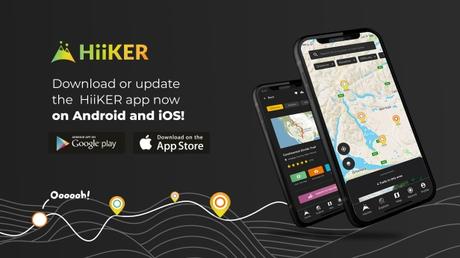Trail Overview
Located in Mount Rainier National Park just outside of Seattle, Washington, the Wonderland Trail circumnavigates the state’s highest peak and active volcano, Mount Rainier, via a 93-mile (150 km) loop with approximately 23,000 ft / 7,090 m of elevation gain.
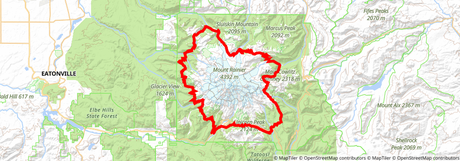
Encircling the most glaciated peak in the Continental United States, the Wonderland Trail takes hikers through a beautiful, dynamic, and wildlife-filled ecosystem spanning subalpine meadows, exploring ancient forests, and skirting alpine glaciers.
The Wonderland Trail is both a challenging and popular backpacking trip; permits are distributed via lottery each year and are oftentimes the first challenge to a trip on the Wonderland Trail. landscape.
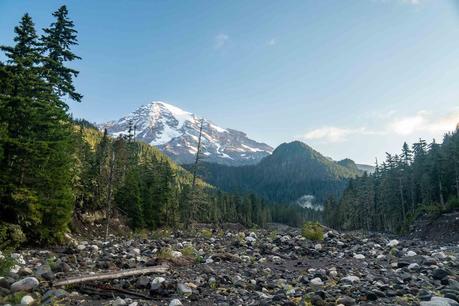
Sample Itinerary
If you’re an ultrarunner, you may want to tackle the Wonderland Trail in a single day, but most trail users will prefer a more leisurely trip around the mountain. There’s a limit of 13 consecutive nights/14 days for summer wilderness permits. Most groups will take around a week to complete the Wonderland Trail.
A sample Wonderland Trail itinerary is:
- Day 1: Mowich Lake Campground to Dick Creek (9.8 mi / 15.77 km)
- Day 2: Dick Creek to Granite Creek (9.3 mi / 14.97 km)
- Day 3: Granite Creek to White River Campground (7.3 mi / 11.75 km)
- Day 4: White River Campground to Indian Bar (11.2 mi / 18.02 km)
- Day 5: Indian Bar to Maple Creek (10 mi / 16.09 km)
- Day 6: Maple Creek to Cougar Rock Campground (9.15 mi / 14.73 km)
- Day 7: Cougar Rock Campground to Devil’s Dream (6.75 mi / 10.86 km)
- Day 8: Devil’s Dream to Klapatche Park (9.8 mi / 15.77 km)
- Day 9: Klapatche Park to Golden Lakes (7.8 mi / 12.55 km)
- Day 10: Golden Lakes to Mowich Lake Campground (10.2 mi / 16.42 km)
Trail Description
Don’t let its popularity fool you, the Wonderland Trail is a serious backpacking endeavour – with long climbs, descents, and the potential for quickly shifting weather. It’s can be beautiful and enjoyable, but also challenging and unpredictable.
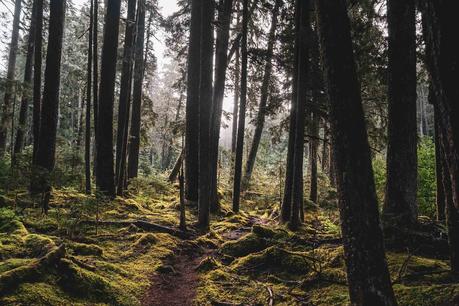
You can technically begin the Wonderland Trail anywhere you would like and it can be hiked in either direction – clockwise or counterclockwise. Your limiting variable is your campsite nightly reservation. Due to its popularity and its location within a national park, the trail is incredibly well-maintained.
You’ll find drop toilets at campsites, bridges over creeks, and informational signs at points of interest. However, despite the well-maintained nature of the trail, there are still some remote sections where you can find yourself far from help should something go wrong.
The tree line on the Wonderland Trail is between 6,500 and 7,500 ft (1,980 and 2,286 m), and the trail spends its time split above and below this point. If for some reason, you need to end your hike early, there are multiple side trails and roads that intersect the main Wonderland Trail route where you can exit the wilderness, if necessary.
Packing List
- Hiiker app
- Gloves
- Pack cover
- Power bank
- Personal locator beacon
- Shell
- Shelter
- Sunglasses
- Sunscreen
- Waterproof mittens
- Waterproof stuff sacks
Permits
Because of the trail’s popularity, Wonderland Trail permits have become increasingly difficult to come by over the years. There are approximately 900 total permits issued each year during the summer hiking season between July and September.
For early-access reservations, a yearly lottery is held in March. Registration for the lottery typically opens during the second half of February. Two-thirds of the available permits are distributed via the early-access lottery. The cost for entering the Wonderland Trail lottery is $6. Any unreserved dates following the lottery will be made available for general sale sometime in April.
The remaining third of the permits are issued on a first-come-first-served basis. These are also known as walk-up permits. These can be only obtained either on the same day your trip starts or one day before. To obtain a walk-up permit you must visit either the Longmire, Paradise, or White River Wilderness Information Center or Carbon River Ranger Station in person. Walk-up permits are not issued over the phone.
All permits issued, whether via the lottery or general sale, cost a flat fee of $20 (plus a $6 reservation fee or lottery fee). Note: you will also be required to pay a Mount Rainier National Park entrance fee of $30 if you do not have a parks pass and plan on driving into the park.
You can enter the Wonderland Trail permit lottery and view all available Mount Rainier National Park wilderness permits at Recreation.gov.
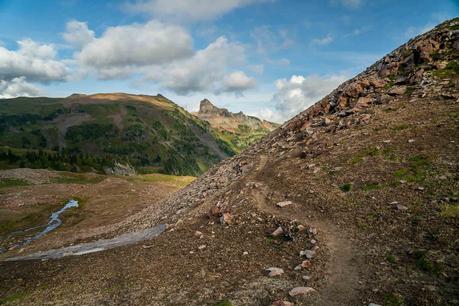
Getting There
Driving is your only option for getting to Mount Rainier National Park as there are no public transportation options available. That said, an expensive taxi or rideshare from Seattle (at least $100) is potentially an option.
All Wonderland Trail trailheads are accessible via paved roads with the exception of Mowich Lake Campground. To reach this trailhead, you’ll travel 16 mi / 26 km on an unpaved road. The road is well-maintained and driving it does not require a high-clearance vehicle or 4WD.
Things to Note
- Groups of six or more hikers are required to use group sites
- If you intend to travel more than 17.5 mi / 28.2 km on any single day of your itinerary, you cannot make a reservation on Recreation.gov and will be required to contact the Wilderness Information Centers following the close of the early access period.
- Stays at any one campsite or zone are limited to four consecutive nights
- You can cache food for yourself or your group at Longmire Wilderness Information Center, White River Campground, Sunrise Old Gas Station, or Carbon River Ranger Station. These caches can be mailed or hand-delivered.
Weather
Weather in Mount Rainier National Park and along the Wonderland Trail can be unpredictable and you should be prepared for anything – especially the cold and the rain.
The driest (and therefore most in-demand) months in the park are July and August. June and September don’t see too much precipitation either (on average), but you can also expect lower temperatures during these months.
That said, keep in mind that the hiking season doesn’t officially being until July and, depending on the year, much of the trail may still be under snow for much of June.
